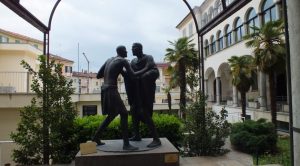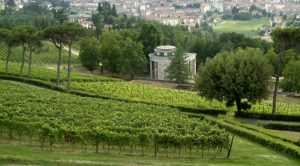- Home
- WORKS OF ART
A charming historic centre that fascinates and captures visitors, where the sound of water follows you everywhere. You may stroll among art and history in a city considered an open-air museum whose monuments and historic sights are a real and surprising testimony to its rich and glorious past.
The Cathedral of Santa Maria Assunta and the Triptych of the Madonna of Montserrat - piazza Duomo

The imposing Cathedral dedicated to Santa Maria Assunta, was consecrated in 1067 by Saint Guy, Bishop and Patron Saint of the city. It has a Latin cross plan divided into one nave with four aisles. Noteworthy is the grand portal, a masterpiece by Antonio Pilacorte (1481) and inside the pulpit dating from the beginning of the 19th century, built using reused marble slabs, and the baptistery in a rococo style is worthy of mentioning. In the sacristy the Triptych of Our Lady of Montserrat is preserved, a masterpiece by the Spanish painter Bartolomeo Bermejo; this opera was commissioned in 1480 by Francesco Della Chiesa a merchant from Acqui Terme in Spain at the time for business, who requested the painting, wanting it to be placed in the family chapel in the Cathedral. In the middle it portrays Our Lady sat on a saw (that represents Montserrat, where the famous Catalan Sanctuary is, which signifies dented mountain), holding Baby Jesus in her arms gazing at a goldfinch tied to a piece of string. The lateral shutters illustrate from the top left the Birth of the Virgin, the bottom left San Francesco receiving the stigmata, the top right the Purification, and the bottom right San Sebastiano dressed in fashionable epoch clothes, holding some arrows in his hand. With the shutters closed it presents the Annunciation.
Also, in the Chapter house, an altarpiece of Lombard School dating from 1496 and the Annunciation, opera by Valerio Castello from 1645 are preserved.
The Cathedral is open everyday from 7.30am-12.00 and from 3.00pm-6.00pm.
Inside the church are many other prestigious works of art. The frescoes of the vault are a masterpiece by Pietro Ivaldi known as “il Muto”, whereas the frescoes of the main apse with the vaults covered by stuccoes and baroque fresco paintings, date from 1668, opera by Giovanni Monevi that also accomplished the grand “Assumption of the Virgin”. Also worthy of mention is the large canvas depicting San Guido, painted by David Corte in 1645.
Ottolenghi Old People’s Home and the Figliol Prodigo – via Verdi
The statue of the Figliol Prodigo is housed in the 16th century hospital of which three orders of loggias are still visible. Thanks to the generosity of Count Arturo Ottolenghi and his wife Herta, the building was renovated in 1934, entrusting the works to the Architect Marcello Piacentini. The decorations are works of art by the artists Ferruccio Ferrazzi and Fiore Martelli. In the garden the famous bronze statue of the “Prodigal Son” can be admired, a masterpiece by Arturo Martini.
Church of San Francesco and the painting collection – Corso Roma
The presence of the Franciscan friars in Acqui Terme dates back to 1224. Between the first half of the 1400s and the beginning of the following century the church and cloister were built.
After the period of decline following the Napoleonic suppression, the church was rebuilt in the 1800s. Inside are some remarkable paintings: the Conception of our Lady, opera by Moncalvo, The Adoration of the Magi by Raffael Aneglo Soleri and Our Lady with Baby Jesus between San Francesco and Sant’ Anthonio of Padova by Pietro Beccaria.
Opening times 8.00am-12.00 and 3.00pm-6.00pm.
Church of the Addolorata - Piazza dell’Addolorata
Built in a Romanesque style with a central nave, two side aisles and an octagonal bell tower leaning against the south apse. It was the abbey church of the former monastery of St. Peter founded by a bishop in the 11th century on the site of a Paleo-Christian cemetery church. Noteworthy inside is a large 15th century fresco of Lombard School "The Compassion with the Bishops San Maggiorino and San Tito”. Not to forget are two 17th century canvases, “Jesus is crowned with thorns” and “Jesus before Pilate”, and the wooden statue of the Madonna Addolorata (Lady of Sorrows).
The Mausoleum – Herta’s Temple Villa Ottolenghi
The villa and Estate at Monterosso is the only example of its kind to be found throughout the whole of Italy, that involved an intense collaboration between architects, painters, sculptors and investors to give life to a country home full of wonderful works of art.
In 1920 Count Arturo Ottolenghi and his wife Herta von Wedekind zu Horst entrusted the design of their home, first to Federico d'Amato and then to the famous architect Marcello Piacentini. The patronage of the Ottolenghi’s brought to Monterosso significant artists such as Ferruccio Ferrazzi, Fortunato Depero, Adolfo Wildt, Arturo Martini, the Masters Ferrari, Fiore Martelli, Rosario Murabito and Venanzio Crocetti.
Following the death of his parents, it was their son, Astolfo that undertook the task of completing his parents’ wish at finishing the opera. The final works were carried out by the landscape architect, Pietro Porcinai, Amerigo Tot accomplished the sculpture balcony and Murabito the graffiti.
Not far from the villa is the impressive mausoleum called "Herta’s Temple" based on a carefully planned scenic design known as "Earthly Paradise". The Temple's monumental portal, in engraved bronze, nickel and copper, is a masterpiece by the wrought iron masters Ernesto and Mario Ferrari, and serves as a prelude to the beauty of Ferruccio Ferrazzi's frescoes and the mosaics realised by the Ravenna and Vatican Mosaic School.
The morphological characteristics and the materials used go beyond luxury and are absolutely out of the ordinary.
GUIDED TOURS FROM APRIL TO NOVEMBER
CLOSED IN THE WINTER
By reservation Tel. 0144 322177 / 335 6312093 accoglienza@borgomonterosso.com









